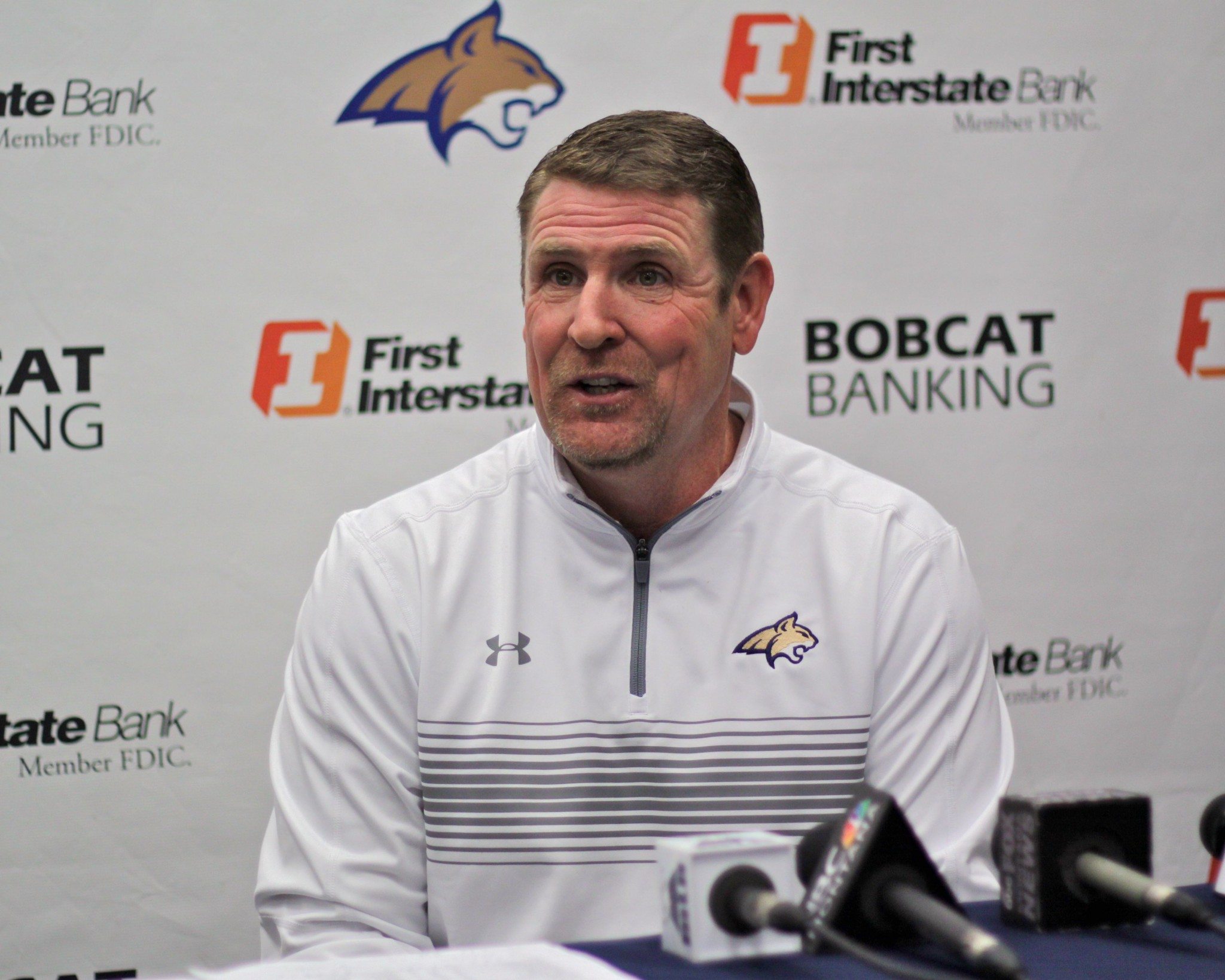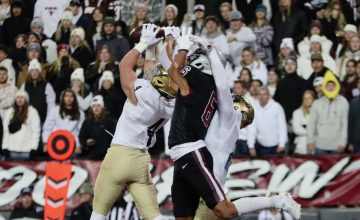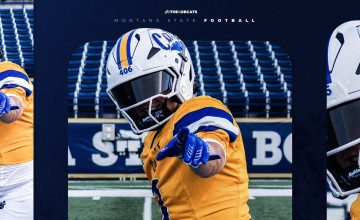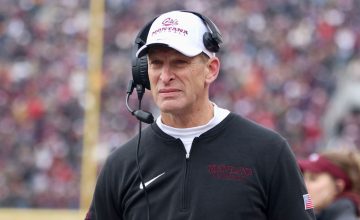As Jeff Choate prepared for a whirlwind first recruiting season, he walked the halls of Brick Breeden Fieldhouse, taking in pictures of Hall of Fame players and Buck Buchanan Award winners. As Montana State’s new head football coach took in his new surroundings, something he already believed to be true was strongly affirmed: recruiting the state of Montana would be crucial as he tried to complete his first signing class in roughly one month’s time.
Banners of players like Butte native Sonny Holland and Billings product Kane Ioane surround Choate’s new office. A picture of Buck Buchanan Award winners Brad Daly and Caleb Schreibeis, each walk-ons turned legends with Treasure State recruits.
It’s in no way feasible to imagine a Montana State football team filled exclusively with Montanans. But when Choate met with his staff for the first time, he decided to put a priority on the state for their first class. On National Signing Day Wednesday, Montana State signed 19 players, including 10 from the state of Montana.
“I think Montana kids have always been the foundation and always will be,” Choate said during Wednesday’s meeting with the media. “You talk about Caleb Schreibeis, Kane Ioane, even the guys who are here right now, they are the backbone of our program, Chad Newell, Gunnar Brekke. I don’t think you can win a national championship here without the foundation being Montana kids. They are the glue for this program and the ones who will give their heart and soul for this place because they grew up wanting to be Bobcats.”
The class has an cumulative grade-point average of 3.42, something the Montana State staff prioritized.
Montana State signed the state’s Gatorade Player of the Year in Bozeman High’s Balue Chapman along with Helena High defensive lineman Chase Benson, Belgrade defensive end Derek Marks, Huntley Project linebacker Michael Jobman, Colstrip offensive lineman Jake Sessions, Great Falls C.M. Russell wide receiver Karl Tucker, Troy running back/athlete Sean Opland, Boulder punter/kicker Jered Padmos, Billings Central wide receiver Jacob Hadley and Dillon defensive end Kyle Finch to National Letters of Intent on Wednesday.
In all, 16 Montana natives signed with Division I schools on Wednesday. Montana second-year head coach Bob Stitt signed Whitefish wide receiver Jed Nagler, Bozeman defensive tackle Trace Bradshaw, Helena Capital defensive end Cole Rosling, Townsend linebacker Jace Lewis and Boulder linebacker Trase LeTexier. Montana offered some sort of aid to Chapman, Benson, Jobman, Sessions, Hadley and Finch while Montana State offered Nagler, Bradshaw and Rosling.
Andrew Grinde, the 2014 Gatorade Player of the Year from Great Falls C.M. Russell as a junior, signed with Yale.
Since his hiring, Choate has consistently tweeted with the hash tag “#BeatTheSkyOwnTheState”. He said Wednesday he thinks Montana State did just that this recruiting season.
“I know this: we signed 10 guys from the state of Montana and easily took care of that job,” Choate said. “If we don’t do that here, we are never going to win big here. In order to win and win big here at Montana State, the foundation is Montana kids. They understand how special this place is. That will always be a priority for me.”
On Wednesday, second-year Montana head coach Bob Stitt proclaimed UM the victor in the in-state recruiting battle, saying the Griz signed “the five best players in Montana.” Choate did not agree but did not delve into an argument of justification.
“I’m not worried about the University of Montana,” Choate said. “I’m worried about Montana State and our kids here. I don’t see it as a competition between them and us. This is about the right kid for us at Montana State. If the fit is right, we will battle for that kid but at the end of the day, these decisions come down to these kids.”
During his first press conference of 2016 the third day of January, Choate identified quarterback, offensive line, the defensive secondary and speed off the edge as the priorities of his first recruiting class. On Wednesday, the Bobcats tried to address each need.
In the middle of Choate’s first week on the job, All-America quarterback Dakota Prukop announced his intention to explore a graduate transfer. By the following week, Prukop was an Oregon Duck. On Wednesday, Choate added three transfers, including quarterback Tyler Bruggman, most recently of Scottsdale Community College. Bruggman, a Phoenix native who earned a four-star recruiting ranking from various national outlets, spent a year at Washington State and another at Louisville.
“At quarterback, I wanted maturity,” Choate said. “You will be blown away when you sit down and talk to Tyler Bruggman. He’s a pro, an exceptional young man with the ability to handle things. He’s assimilated into our locker room seamlessly, which is so important when you bring in a transfer quarterback.
“He was one of the most highly recruited quarterbacks in the country out of high school and he’s here because he wants to maximize that.”
The recruiting class also includes UNLV transfer Alex Neale, a redshirt freshman who should challenge to replace Joel Horn at center and Naijiel Hale, a former four-star cornerback who started two games as a true freshman at the University of Washington in 2014. Choate and secondary coach Gerald Alexander were both on the UW staff when Hale was a freshman. He was dismissed from the team in August of 2015.
“Naijiel made a conscious choice to not enroll in junior college because he didn’t want to have to get his AA to be eligible,” Choate said. “This is good for him because he’s coming to a place where he can have a fresh start in an environment that is good for him where he can focus on football and school.”
Neale, a former three-star recruit who won a state championship at Eastside Catholic in Seattle in 2013, was originally committed to Montana. UNLV came in late, luring Neale to Sin City.
Choate said “having patience” was the most difficult part of the process, confirming that his staff still has scholarship money left over with an eye on adding more transfers in the off-season. Choate said interior defensive line and the secondary would be the primary points of emphasis.
MSU’s Class of 2016 also includes a pair of prep quarterbacks from California, highlighted by Lawndale product Chris Murray. The athletic 6-foot-4 dual-threat signal caller chose MSU over Big Sky rival Eastern Washington. Murray threw for more than 3,000 yards and rushed for more than 2,000 yards as Lawndale won its first Ocean League title in 50 years.
“I wrote on the recruiting board, ‘long, fast or both’ and Chris Murray checks off both those boxes,” Choate said. “He’s 6-4 and he can fly. The dude is not a bad passer. He’s a kid who’s not as polished. He didn’t go to Elite 11 camps. But this guy’s ceiling is through the roof.”
The Bobcats also added Charter Oak (California) quarterback Kamden Brown, a 6-foot-2, 190-pounder who led his team to the CIF Central championship last season., as a walk-on.
The Bobcats also lose starting tackles John Weidenaar and Alex Eekhoff along with Kyle Godecke, a starter for parts of three years at guard. J.P. Flynn, the lone returning starter, suffered a serious knee injury that required off-season surgery in MSU’s season-ending loss to Montana. Neale and Sessions are joined by Taylor Tuisasosopo, a 6-foot-3, 310-pound guard from a strong football lineage that Choate calls a road grader.
“Offensive line was a huge concern for me when I got here,” Choate said. “We have some good young guys in the program but it’s a developmental position. We had a group who played at a high level for a number of years that are gone. We needed to address that.”
A season ago, Montana State posted a 5-6 record, its first losing season since 2001, in no small part because of a secondary that struggled. MSU loses senior cornerback Bryson Keeton and senior safety Desman Carter from last season’s squad. Wednesday, Hale and Brown’s Charter Oak teammate Damien Washington.
MSU did not sign a safety.
Choate said the staff made a point to identify players with length in their limbs. In today’s college football, Choate said, teams are trying to spread you out so you need as much length as possible to cover space. With 6-foot-6 Totino-Grace High (Minneapolis) defensive line Lewis Kidd, the 6-foot-5 Benson, the 6-foot-5 Jobman, the 6-foot-4 Finch, the 6-foot-3 Marks and the 6-foot-2 Chapman, the Bobcats added a handful of long, athletic players with position versatility and flexibility.
Choate said Kidd could play either side of the ball and might end up as a defensive tackle some day. Benson can play inside and outside the defensive line. Jobman has played standup linebacker but is slated as a defensive end, as are Finch and Marks. Choate said he could see Chapman as a pass rush specialist, a standup defensive end, an outside linebacker or even an inside linebacker.
“We put an emphasis on getting longer and people say what is length? It’s height plus wing span,” Choate said. “A kid who is 6-2 who has a 6-5 wing span is going to play more like 6-5. If you look at the front-seven guys we signed, their average height was almost 6-4. We are trying to eat up space on the line of scrimmage on the defensive side of the ball and create space for ourselves at the line of scrimmage on the offensive side of the ball.”
The Bobcats did not lose any of its top six running backs from a season ago, yet still added Opland and speedy Anthony Pegues, a 5-foot-8, 185-pound stick of dynamite running back from Frisco, Texas, to the stable. Pegues is the lone Lone Star State recruit for the Bobcats from an area that has traditionally reaped talent for MSU.
“I don’t think we lost any momentum,” said Bo Beck, MSU’s recruiting coordinator and primary Texas recruiter. “A lot of it had to do with what our needs were. The kids that were committed to us that we didn’t sign (Darrius Mosley, Dawonya Tucker, Marcus Simpson), I’ll nicely say that they didn’t meet the qualifications when it was all said and done. It wasn’t a matter of us getting rid of them. They weren’t going to make some of the grades.”
MSU also added help in the skill positions with three of Montana’s most productive offensive players in Tucker, Opland and Hadley. The 6-foot-2, 205-pound Tucker had nearly 1,500 yards from scrimmage and scored 15 total touchdowns for the Rustlers. The 5-foot-11, 193-pound Opland rushed for more than 1,400 yards, averaging 9.1 yards per carry and scoring 14 touchdowns while also dominating on defense from his linebacker position. The 6-foot-6 Hadley caught 35 passes for 635 yards and 11 touchdowns in the Rams’ run-heavy offense.
According to national recruiting sits like Scout.com and Rivals.com, MSU signed two recruits who once held four-star recruits in Bruggman and Hale, two more three-stars in Neale and Pegues and two two-stars in Padmos and Oak Ridge (El Dorado Hills, California) wide receiver Kevin Kassis.
“I don’t buy into a lot of the stars thing,” Beck said. “If you are telling me at the end of the day that Caleb and Brad aren’t five-star guys, that’s wrong.
“I think some of the big schools, you get in trouble if you don’t sign five-star guys. But it’s my personal thought that five-star recruits, some of them, are the best they are ever going to be at 18 years old. And you might have a one-star, two-star who will be a way better player at 22 years old. I think that’s where you see the downfall of some of the big programs. They sign a whole class of five-star guys and a place like Texas, Notre Dame, USC are losing. You need the non-star guys and you blend them in with a couple of cats like that, great. But at the end of the day, all these guys have to produce.”
Click on player names to link to full recruiting stories.














